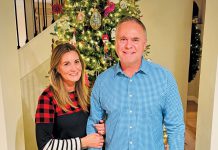When the first rains of the season came down, the forest turned gloomy and the trees looked like druid totems. The seeping skies crushed the optimism out of me, and I began to ramble about my house, muttering in dread, “Winter is coming. Winter is coming.”
Squirrels with cheeks fat with acorns running along the deck and a sapling full of migrating ruby-crowned kinglets reminded me that the seasons were changing.
But when the rains rolled away, Indian summer rolled in and revealed a heaven so deep that you could fall into that lighted sky and the color alone would catch you.
Although a meteorologist could say that the warm days that followed the rains were brought on by offshore winds that pushed the air mass toward the ocean — instead of the more common weather pattern of cool Pacific Ocean winds blowing onshore — the vivid light was more than science could explain.
Suddenly, around every turn, trees like the big-leaf maple displayed their bodacious colors of hot corals and fuchsias. For others, their leaves changed to a rich honey in the Indian summer light.
I recently asked others what this season meant to them.
Chet Bardo, district superintendent for State Parks and Recreation:
“You caught me at a good time. I just returned from a walk along the River Trail (in Henry Cowell Redwoods State Park). What caught my attention was the carpet of leaves from the sycamore and cottonwood trees and the musty, organic smell of decomposition, the way the winds bring out the smell of the rain-washed bay trees. Even the ocean smells different this time of year. The ocean has churned up and cleaned the beaches. Even the salt smells more like salt.”
Elaine Golling, Felton designer:
“Autumn has always been my favorite time of the year. I feel the colors, the crisp in the day, the sun. It’s comfortable and inspirational and makes me want to do things. I’ll putter in the garden and harvest some pumpkins and use them in autumnal designs on the porch. When you’re outside, you appreciate everything, not like working in a cement building, which I used to.”
Fred McPherson, Boulder Creek naturalist and biological teacher:
“After the first rains, the forest becomes alive. I can smell the fungus and the moss, the redwoods and the firs. The feeling of rejuvenation is like spring. Everything becomes biologically active. I love to note of all these things and the colors of the leaves in my journal.”
Christine Richie, owner of Scotts Valley Feed:
“Thanks, Carol, for the opportunity to really think about what fall means to me. To me, fall means ‘new coats.’ Gone are the brown hills, as the first rains have come and the new green grass covers the ground.
“My chickens have dropped (molted) their old dusty feathers and put on their new shiny smooth feathers for winter. Customers come in and want to know what’s wrong with their chickens. They’re not laying eggs anymore, and they don’t look as clean. I tell them that during the fall, the hens are using all their energy to grow new feathers.
“The horses have grown their coats long and shaggy to keep them warm. My cats are fluffy and thick-coated for the coming cold. I love all these ‘new coats.’”
I happened upon a lone coyote a few days ago on the Meadow Trail at Cowell. She and I looked at each other for awhile, both wary but peaceable. Her coat was sleek and colorful, with russet ears and head and white lines around her mouth. She did not have her winter coat yet. She was stalking berries and rodents, and I was stalking Indian summer.
Carol Carson, a nature writer and educator, has a master’s in education and has been a docent at Henry Cowell Redwoods State Park. She has also taught courses at UCSC Extension on Big Basin State Park. Contact her at ca****@*********on.com.











